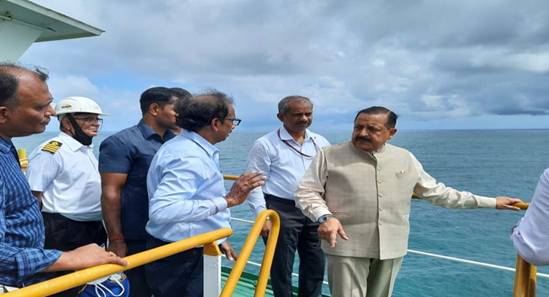Union Minister Dr Jitendra Singh visits Indian Subcontinent’s Pioneer Research Vessel Ship “Sagar Nidhi” and interacts with top Scientists on the deck
New Delhi: Union Minister of State (Independent Charge) Science & Technology; Minister of State (Independent Charge) Earth Sciences; MoS PMO, Personnel, Public Grievances, Pensions, Atomic Energy and Space, Dr Jitendra Singh today visited the Indian Subcontinent’s Pioneer Research Vessel Ship “SagarNidhi” and interacted with the Scientists on the deck.
Secretary Earth Sciences, Dr M. Ravichandran told the reporters that Dr Jitendra Singh is the first ever Science & Technology Minister to have accompanied the Scientists when the ship sailed from the Chennai Port.
The Minister also reviewed the Research Fleet of National Institute of Ocean Technology under Ministry of Earth Sciences at Chennai Port with leading Scientists.
Dr Jitendra Singh noted the role of SagarNidhi in exploring the ocean resources and participation in search and rescue operations, more specifically its importance for implementation of Deep Ocean Mission. The vessel is capable of carrying out geo-scientific, meteorological and oceanographic research, and is designed with blue-water capability with ranges of up to 10,000 nautical miles (19,000 km) for voyages lasting up to 45 days.
The Minister appreciated the support extended by Chairman and officials of the Chennai Port Trust for support in implementation of R& D activities of the Ministry. He boarded the Ship ORV SagarNidhi, India’s state of the art ice-class research vessel and went on a short cruise during which, he reviewed the scientific & technology demonstration capabilities of the Ships and its capabilities. He was informed that SagarNidhi is the first Indian flagged research ship that reached the 66°S latitude [Antarctic waters], facing 11 storms and 73 nm/hr wind speed, witnessing nature’s harshest conditions.
Dr Jitendra Singh was apprised of the ship facilities like handling gear, propulsion and control systems. He observed that such technology demonstration vessels are required for exploration and harnessing ocean resources for the Blue Economy. He praised the valuable contribution of these Research Ships towards enhancing the knowledge on oceans and also reviewed the fleet of research vessels comprising SagarManjusha, Sagar Tara and SagarAnveshika.
Dwelling on the issue of Deep Ocean Mission, Dr Jitendra Singh said that the Union Cabinet has approved it in June this year to be implemented by Ministry of Earth Sciences at a total budget of Rs. 4077 Cr for 5 years. The Minister said, the Deep Ocean Mission is a multi-ministerial, multi-disciplinary programme with emphasis on development of deep-sea technology that includes development of manned Submersible rated for 6000 metre water depth along with technologies for deep sea mining, exploration of deep-sea mineral resources and marine biodiversity, acquisition of a research vessel for ocean exploration, deep sea observations, and capacity building in Marine Biology.
Dr Jitendra Singh underlined that private institutions will also be included for development of technologies for this mission to explore the possibilities of mining, biodiversity, energy, fresh water, etc. in deep ocean and to support the ‘Blue Economy’. The Minister added that it is planned to develop a manned submersible to carry 3 people to a depth of 6000 metres in the ocean with suit of scientific sensors and tools. All the components of the mission will commence in 2021.
The Ministry of Earth Sciences (MoES) has the mandate of providing weather, climate, Ocean and seismological services and to harness living and non-living resources. MoES is also involved in development of relevant Ocean Technology and Ocean Survey of the Exclusive Economic Zone (EEZ) and deep oceans for minerals and energy. National Institute of Technology (NIOT) Chennai has the mandate to develop technologies for the sustainable harvesting living and non-living resources of the ocean.
NIOT has successfully developed and demonstrated the technologies like Desalination Plants for drinking water in Lakshadweep Islands, extracting energy from Oceans, Restoration of Beach in Puducherry, development of Remotely Operated Underwater Vehicles (ROV) and mining machine for 5500 metre water depths. NIOT also has the mandate to deploy and maintain moored data buoys for the data collection that aids in the weather prediction, cyclone tracking and Tsunami Early Warning.
Research Vessel (Ships) is an important tool for ocean research and development of ocean technology. MoES has, at present 6 ships, SagarNidhi, SagarManjusha, SagarKanya, SagarSampada, Sagar Tara &SagarAnveshika, which are used for many ocean studies and applications including ocean observations.
India, a traditionally maritime country with rich maritime heritage, has an Exclusive Economic Zone (EEZ) of about 2.37 million square kilometres wherein India enjoys the exclusive legal right to utilize all living and non-living resources. Apart from this, India has been allotted 75000 square kilometers in the Central Indian Ocean 10000 sqare kilometres in the Southern Indian Ocean by the International Seabed Authority. These areas are rich in minerals like Manganese, Cobalt and Nickel. For the sustainable harvesting of these non-living and living organisms we need to explore and understand the ocean.

